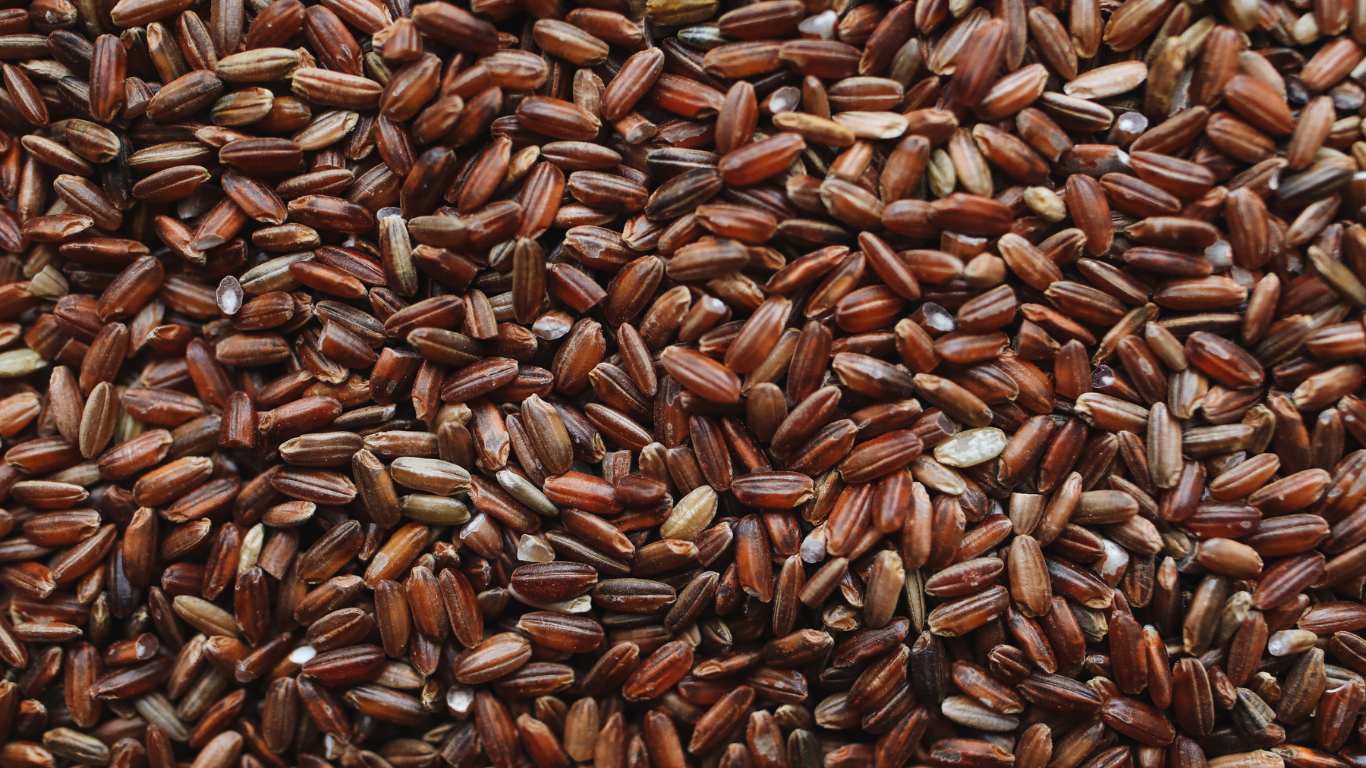Karuppu Kavuni Rice has deep roots in Tamil Nadu, where it’s been grown for centuries. Historically, it was a luxury grain, reserved for kings and nobles due to its rich nutrients, earning the name “Forbidden Rice.” In ancient Tamil culture, it was used in special feasts, temple rituals, and celebrations, symbolizing wealth and health. Farmers in regions like Thanjavur, known as Tamil Nadu’s “Rice Bowl,” cultivated it using traditional methods. Its striking black-purple color comes from anthocyanins, a natural pigment also found in berries. Though its use dipped in the 20th century due to modern white rice varieties, it’s gaining popularity again in 2025 as people seek healthier, organic options, bringing this ancient grain back to kitchens across India and beyond.
What Makes Karuppu Kavuni Rice Special?
Karuppu Kavuni Rice stands out for its unique color and amazing nutritional value. The deep purple-black shade comes from anthocyanins, powerful antioxidants that fight harmful free radicals in the body. It’s richer in fiber than brown rice—about 4.9 grams per 100 grams—and has more protein, making it a filling and healthy choice. It’s also packed with iron, zinc, and vitamin E, which help with energy, immunity, and skin health. With a low glycemic index, it releases sugar slowly, making it great for managing blood sugar levels. Plus, it’s naturally gluten-free, perfect for those with gluten sensitivity. Its nutty flavor and chewy texture make it a versatile ingredient for both sweet and savory dishes in 2025.
Rich in Antioxidants
The black color of Karuppu Kavuni Rice isn’t just pretty—it’s a sign of its high antioxidant content. Anthocyanins, the same pigments in blueberries, help protect your body from damage by free radicals, which can lead to diseases like cancer or heart issues. Studies mentioned on websites like organicpositive.in show this rice has six times more antioxidants than white or brown rice. This makes it a fantastic choice for boosting overall health, reducing inflammation, and even supporting a longer life. Adding Karuppu Kavuni Rice to your meals in 2025 is an easy way to get these benefits while enjoying a tasty, traditional grain.
High Fiber for Better Health
Karuppu Kavuni Rice is a fiber powerhouse, with 4.9 grams per 100 grams, double that of brown rice, as noted on sites like vayalfoods.com. This fiber helps your digestion, prevents constipation, and keeps your gut healthy by feeding good bacteria. It also makes you feel full longer, which can help with weight management—a big plus in 2025 with rising health concerns. The slow release of energy from its complex carbs keeps you active without sudden hunger spikes, making it a smart choice for anyone looking to eat better and stay fit while enjoying a traditional South Indian staple.
Health Benefits of Karuppu Kavuni Rice
Karuppu Kavuni Rice offers a range of health perks, making it a top pick for healthy eating in 2025. Its antioxidants help fight heart disease by lowering bad cholesterol and protecting arteries. The high fiber content aids digestion, prevents constipation, and supports weight loss by keeping you full longer. With a low glycemic index, it’s ideal for managing diabetes, as it releases sugar slowly into the blood. It’s also gluten-free, great for those with celiac disease. Plus, it’s rich in iron, zinc, and vitamin E, boosting immunity, energy, and skin health. From supporting pregnant women to improving eye health, this rice is a nutrient-packed addition to any diet.
Helps with Weight Management
Karuppu Kavuni Rice is a great ally for weight management. Its high fiber content—4.9 grams per 100 grams—makes you feel full longer, reducing the urge to snack, as mentioned on bnborganics.com. The low glycemic index ensures a slow energy release, preventing sudden hunger spikes. This helps you eat less without feeling deprived, a key factor for weight loss in 2025. Customers on sites like salemmango.com have shared losing up to 5 kg in a month by eating this rice twice daily as porridge. It’s a natural, healthy way to manage your weight while enjoying a tasty grain that’s been cherished for centuries in Tamil Nadu.
Supports Diabetes Control
For those managing diabetes, Karuppu Kavuni Rice is a smart choice. Its low glycemic index means it releases glucose slowly, avoiding sharp blood sugar spikes, as noted on standardcoldpressedoil.com. The high fiber content also helps regulate sugar levels by slowing digestion, making it easier to control diabetes. People on platforms like salemmango.com report that eating this rice daily as porridge has helped stabilize their sugar levels, even for those on insulin. In 2025, with diabetes on the rise, adding Karuppu Kavuni Rice to your diet can be a simple, natural way to manage your health while enjoying a traditional South Indian grain.
How to Cook Karuppu Kavuni Rice
Cooking Karuppu Kavuni Rice is a bit different from regular white rice because of its unique texture. Soak the rice for 4-6 hours, or overnight, to soften it, as suggested on amazon.in. Use 2.5 cups of water for every cup of soaked rice—bring it to a boil, then simmer until tender, which takes about 30-40 minutes. You can also use a pressure cooker for faster results, cooking for 3-4 whistles. Its nutty flavor makes it perfect for dishes like porridge, dosa, idli, or even desserts like payasam with jaggery and coconut milk. In 2025, this rice is a great way to add variety and nutrition to your meals with traditional South Indian recipes.
Making Karuppu Kavuni Porridge
Karuppu Kavuni Porridge, or Kanji, is a popular breakfast dish in Tamil Nadu. Soak 1/4 cup of Karuppu Kavuni Rice for 3 hours, then grind it into a coarse powder, as shared on thanjaiorganics.com. Boil 4 cups of water, add the powder, and stir on medium heat until it thickens—about 15 minutes. Add a pinch of salt and mix well. Once cooled, you can stir in curd or buttermilk for a tangy taste. This porridge is light, nutritious, and perfect for a healthy start to your day in 2025, offering the benefits of fiber and antioxidants while keeping you full and energized.
Using It in Sweet Dishes
Karuppu Kavuni Rice shines in desserts thanks to its nutty flavor. A classic dish is Kavuni Arisi Payasam, a South Indian pudding. Soak 1 cup of rice overnight, then cook it in a pressure cooker with 3 cups of water until mushy, as noted on dmtraders.com. In a pan, heat 1 cup of jaggery syrup, add the cooked rice, and stir in 1/2 cup of coconut milk with a pinch of cardamom powder. Cook on low heat for 10 minutes until thick. Garnish with nuts. This dessert, popular in 2025, is a healthy, sweet treat packed with nutrients, perfect for festivals or special meals.
Where to Buy Karuppu Kavuni Rice in 2025
You can find Karuppu Kavuni Rice online or in stores across India in 2025. Websites like jiomart.com, amazon.in, and bnborganics.com offer it in packs from 1 kg to 5 kg, priced between ₹150 to ₹350 per kg, depending on the brand. Look for organic options from sellers like Thanjai Organics or B&B Organics for the best quality. Many offer free shipping on orders above ₹500, as seen on ulamart.com. Local markets in Tamil Nadu, especially in Thanjavur or Chennai, also sell this rice through farmers’ cooperatives like Salemmango. Always check reviews for freshness—some buyers on amazon.in have reported issues with insects, so choose trusted sellers to ensure you get pure, high-quality rice.
Challenges of Using Karuppu Kavuni Rice
While Karuppu Kavuni Rice is amazing, it has some challenges. It needs to be soaked for 4-6 hours before cooking, which takes time, as noted on amazon.in. Some buyers on sites like bnborganics.com mention a high price—₹300-350 per kg—compared to white rice, which might not suit every budget in 2025. There have also been complaints on amazon.in about insect infestations or a strange smell, like a “Gamaxin type” odor, even after washing. Its availability can be limited outside Tamil Nadu, though online stores help. Despite these issues, its health benefits make it worth trying—just buy from trusted sources and store it properly to avoid spoilage.
Cooking Time and Preparation
Karuppu Kavuni Rice takes longer to prepare than regular rice. You need to soak it for at least 4-6 hours, or overnight, to soften its tough outer layer, as advised on amazon.in. Cooking can take 30-40 minutes on the stove or 3-4 whistles in a pressure cooker, which might feel slow in a busy 2025 schedule. Without soaking, it stays hard and chewy, making dishes less enjoyable. Planning ahead is key—set aside time to soak it, and you’ll get a tender, flavorful rice that’s perfect for both traditional South Indian recipes and modern dishes, all while reaping its health benefits.
Price and Availability Concerns
Karuppu Kavuni Rice can be pricey, costing ₹150-350 per kg, as seen on bnborganics.com, much more than white rice. This might be tough for budget-conscious buyers in 2025. It’s also not as widely available—mostly found in Tamil Nadu or online through sites like jiomart.com. Some users on amazon.in have reported issues like insect infestations or poor quality, which can make you hesitant to buy. To avoid this, choose trusted brands like Thanjai Organics, check reviews, and store the rice in an airtight container. Despite the cost, its health benefits make it a worthwhile investment for a nutritious diet.
Final Thoughts on Karuppu Kavuni Rice
Karuppu Kavuni Rice is a true gem from Tamil Nadu, blending tradition with modern health benefits in 2025. Its antioxidant-rich profile, high fiber, and low glycemic index make it a superfood for weight management, diabetes control, and overall wellness. Though it takes time to cook and can be pricey, its nutty flavor and versatility in dishes like porridge and payasam make it worth the effort. Available online and in local markets, this black rice is a great way to support farmers and eat healthier. Add Karuppu Kavuni Rice to your meals this year for a tasty, nutrient-packed option that honors South India’s rich culinary heritage.




